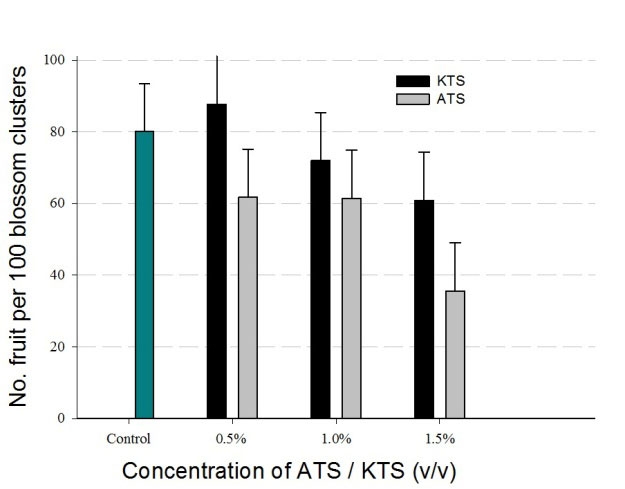With little information available on chemical thinning programs for European pears, or on the effect of chemical thinning agents on pear fruit quality, it is difficult for growers to put together effective thinning programs for their crops.
Reliance on hand-thinning for crop load management is expensive and often affects fruit size and quality as during early fruit development the tree puts its resources into fruit that is removed several weeks after bloom.
However, a targeted chemical thinning program allows removal of excess fruit early in the season—thus optimising fruit quality.
Unless properly understood, the use of chemical thinners can involve a large commercial risk.
Although all available chemical thinners have some limitations, a chemical thinning program produces markedly superior results to hand thinning both economically and in terms of tree physiology.
The most effective chemical thinning programs combine blossom and post-bloom thinners. A sequential spray program allows lower quantities of chemical to be used at each timing, thus reducing the risk of over thinning.
If the chemical thinners have been effective then all that should be required is a subsequent light hand thin to remove damaged fruit or break up any remaining bunches.
Work described in this article
The work described in this article was undertaken with the aim of providing reliable recommendations for chemical thinning of pear cultivars.
Trial work was undertaken on the cultivar Packham’s Triumph (Packham) over a period of three years in both the Goulburn Valley, Victoria and at Nubeena, Tasmania.
Results from the two regions have proved to be very similar, demonstrating that results and recommendations arising from trial work undertaken in the cooler Tasmanian conditions are applicable to other growing areas in Australia.
Chemicals examined included the desiccating agents ammonium thiosulphate (ATS) and potassium thiosulphate (KTS) and the hormonal thinner ethephon applied during the flowering period and 6-benzyladenine (BA) applied as a post-bloom thinner.
Desiccants for thinning
Desiccating chemicals have a different mode of action to the hormonal type chemical thinning agents such as ethephon or NAA that have been used for many years in Australia.
Desiccants act by burning the pistil (which consists of the style and stigma) of the flower, thus preventing pollination and fertilisation from occurring.
Pollination occurs when pollen lands on the stigma and germinates. Germinated pollen tubes grow down the style to reach the ovary and fertilise the ovules. (Figure 1).
Hence desiccants need to be applied after the flower has opened so that the desiccant can reach the pistil, but before any pollen tubes from germinated pollen grains are able to reach and fertilise the ovules. Once this has occurred desiccants will have no effect on crop load.
Time of application
When using desiccants, time of application is critical in achieving a satisfactory level of thinning.
Desiccants need to be applied when sufficient flowers have already been fertilised to give a good crop load. These earlier setting fruit are also normally larger and better quality than later setting fruit.
Both ATS and KTS proved to be effective thinning agents for Packham, but ATS is a more aggressive thinner than KTS (Figure 2). As only one trial was conducted with KTS, further work is required to develop recommendations for this desiccant.
The trials conducted with ATS have shown that there is an increased thinning effect with increasing concentration, and also with number of applications (Figure 3).
Recommendation
The recommendation arising from this work for use of ATS as a blossom thinner for Packham pear is an initial application of 1.0% ATS at around 25% bloom stage, with a follow up second application from 50% bloom to enhance the thinning effect.
Once full bloom has been reached it is too late to apply desiccants as most flowers will already have been fertilised.
If conditions are unfavourable for pollination, that is,cool wet weather with few active bees; or a netted orchard, then spray application should be delayed to ensure adequate fruit set.
The physical mode of action of desiccants makes them less dependent on weather conditions than hormonal type thinners, however, the degree of desiccation can be influenced by temperature—with higher temperatures resulting in greater desiccation.
While leaf damage does occur with desiccants, the degree of damage that occurs when using the recommended rates does not affect fruit development, size or quality.
Post-bloom thinning (continued next month)
For more information, see Tree Fruit August 2015






















